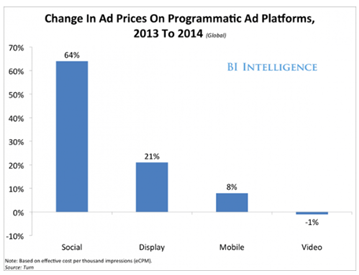Save 50% on a 3-month Digiday+ membership. Ends Dec 5.

Written by Darline Jean, COO, PulsePoint
The premise that the rise of automated buying and selling through programmatic technology would have a negative impact on a publisher’s ability to increase – or even maintain – their CPM rates is continuing to erode. Many were surprised to learn that the 2013-2014 CPM trend for social, mobile and display across programmatic ad platforms was one of growth – not decline.
As the click fades as the metric of prominence, contextual data, viewability and high impact opportunities for engagement have become increasingly valued and sought after by brands. Today marketers realize more and more that “you get what you pay for” but they expect that price tag to come with the same scale and efficiency programmatic technology delivers. So how can publishers use data and technology to command premium pricing for the premium experiences brands want – and consumers expect?
Here are four strategies publishers can adopt to not simply survive – but thrive – in a programmatic world.
Make your audience and contextual site data available and visible to buyers.
Move beyond offering just standard cookie-reliant targeting with contextual technology. Real-time, page-level contextualization of your content increases the likelihood that a person sees an ad that’s relevant to them – delighting your audiences and the buyers who want to reach them. Contextual analysis at the page level will enable you to offer audience segments interested in that content at greater scale, beyond first-party and third-party cookie pools. Contextual data can help increase yield and revenue by showing the value of inventory buyers would normally overlook.
Upgrade your site to support more advanced ad functionality and cross-screen delivery.
Large-format, high-impact ad sizes are designed to help brands get their ads noticed and have been shown to improve interaction rates, increase time spent and improve brand recall. The IAB recently released that consumers find Rising Star ads more engaging and more informative than standard units. This makes them especially valuable to brands, who tend to bid higher on these formats. With an estimated 60 percent of web traffic coming from mobile, it goes without saying that your site should be mobile optimized. It’s worth spending the time and money to upgrade your site internally, or many technology partners can help you integrate new ad formats and optimize for mobile experiences quickly and easily.
Ad position: web_incontent_pos1
Understand how much of your content is viewable – and make sure you can deliver against it.
Viewability is moving from “nice-to-have” to “must-have” in a buyers mind. Make sure you know how much of your inventory is viewable and provide transparent reporting against that number to clients. Publishers who can offer a pricing model that incorporates viewability (e.g vCPM) will emerge the winners, as brands will pay a premium for guaranteed viewable inventory. An easy way to get started is to ask your monetization partners if they have viewability-tracking and reporting tools to layer on your current offering – some even offer this as a value-add service.
Adopt a “test and learn” approach to programmatic partners.
Don’t accept the status quo from your current monetization partners. As the programmatic landscape matures, earlier pain points of integrating new technology partners are starting to subside as onboarding and operational processes have become standardized. There’s no such thing as a “one size fits all” programmatic partner, so don’t be afraid to test multiple providers concurrently to compare performance – leverage the real-time nature of programmatic to find the right solution that will help ensure a premium for your unique audience and content.
This isn’t the first time publishers have been forced to evolve alongside major industry change, and it most certainly won’t be the last. By 2018, more than 80 percent of display ad dollars will be transacted programmatically. Publishers that adapt to this new way of doing business and embrace the innovation it spurs will be the ones to reap the benefits.
More from Digiday

Ulta, Best Buy and Adidas dominate AI holiday shopping mentions
The brands that are seeing the biggest boost from this shift in consumer behavior are some of the biggest retailers.

Digiday+ Research Subscription Index 2025: Subscription strategies from Bloomberg, The New York Times, Vox and others
Digiday’s third annual Subscription Index examines and measures publishers’ subscription strategies to identify common approaches and key tactics among Bloomberg, The New York Times, Vox and others.

U.K. retailer Boots leads brand efforts to invest in ad creative’s data layer
For media dollars to make an impact, brands need ad creative that actually hits. More CMOs are investing in pre- and post-flight measurement.
Ad position: web_bfu

